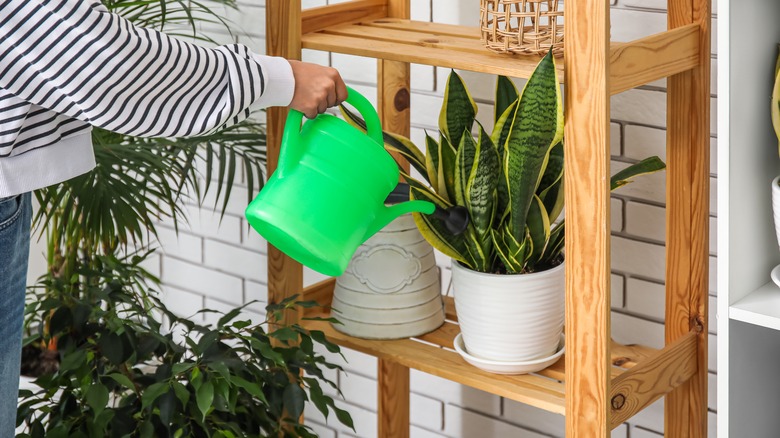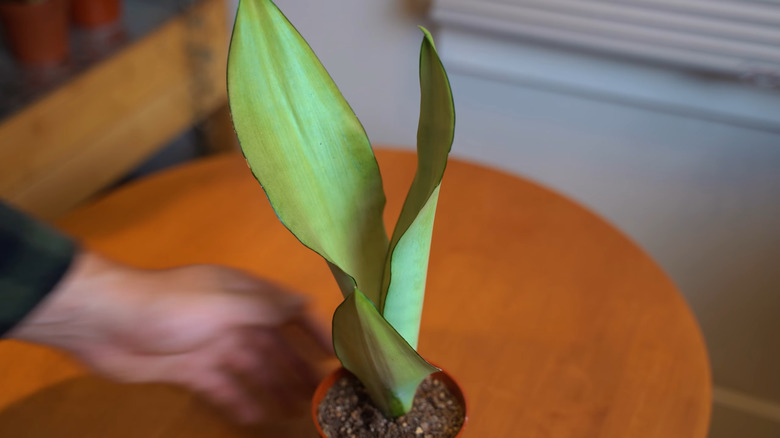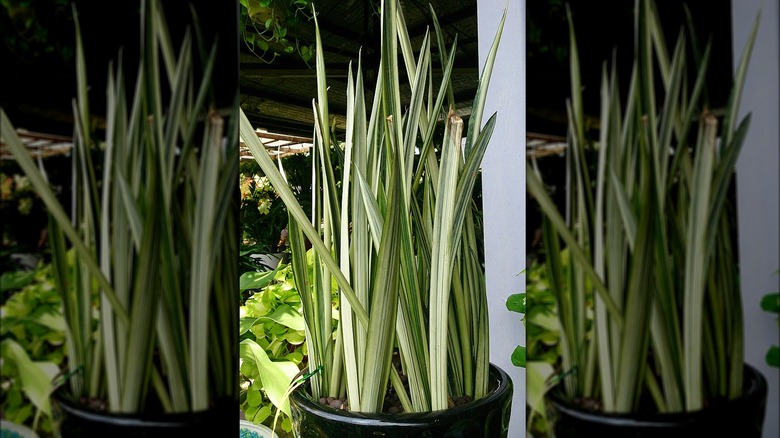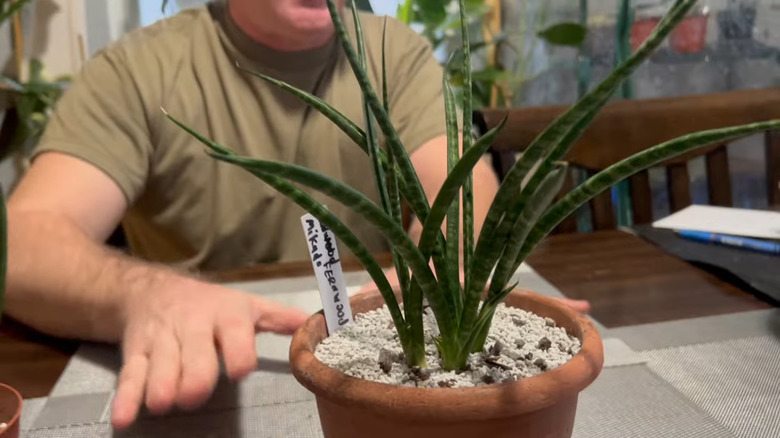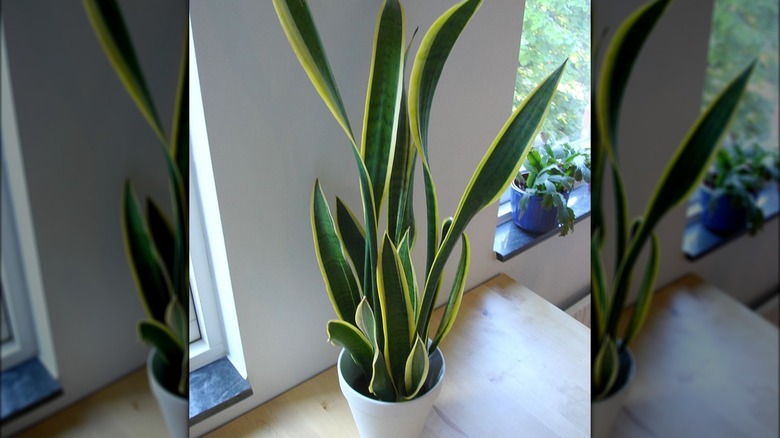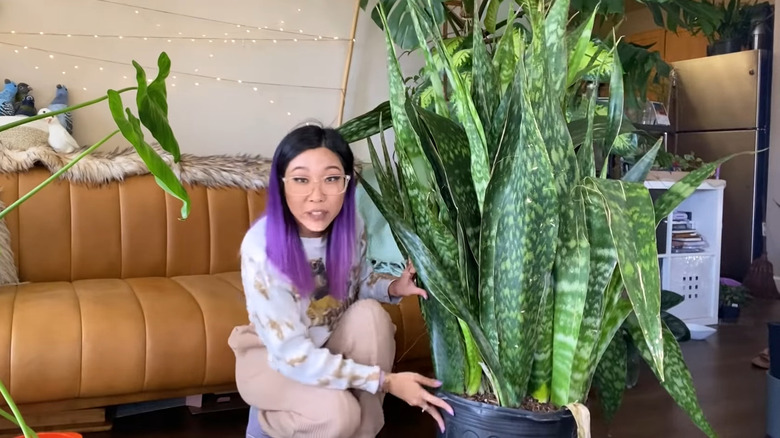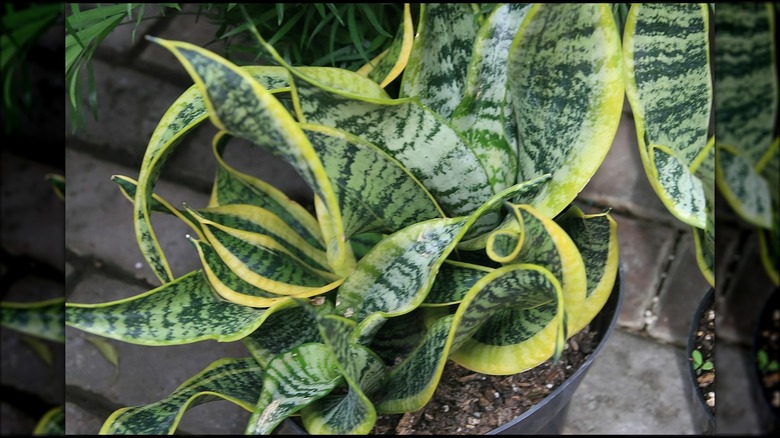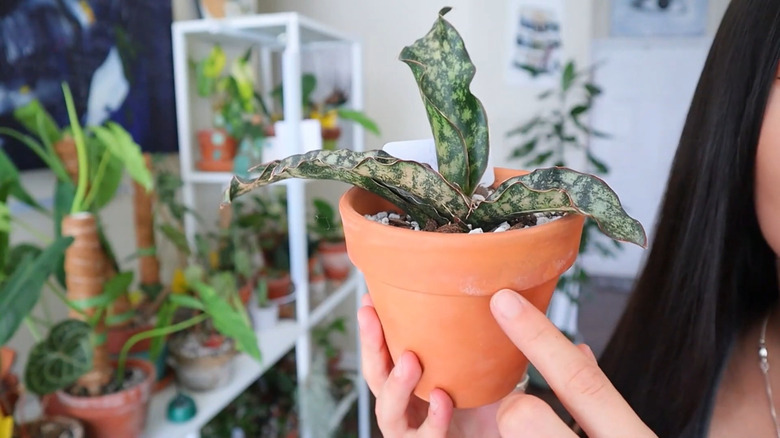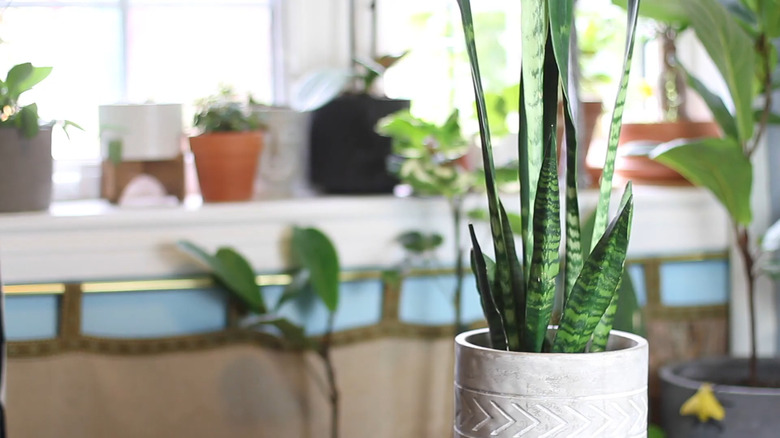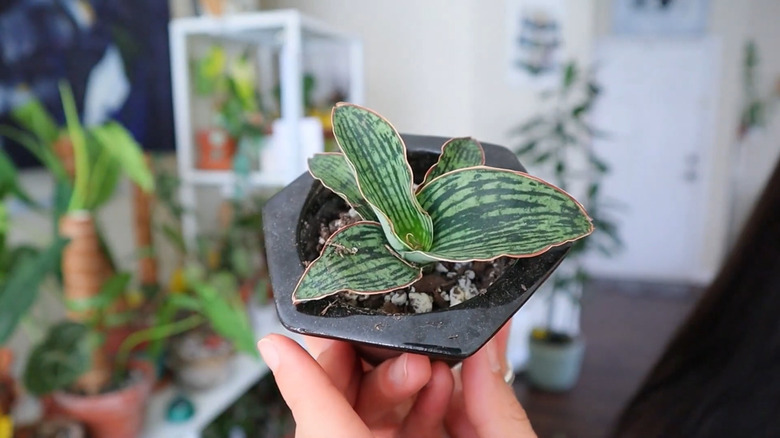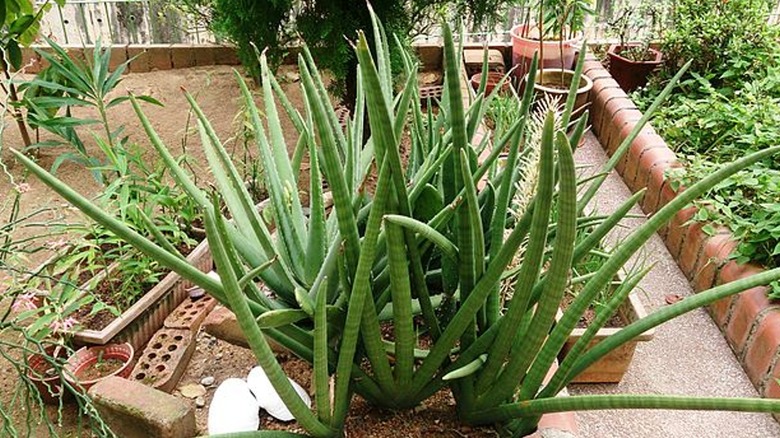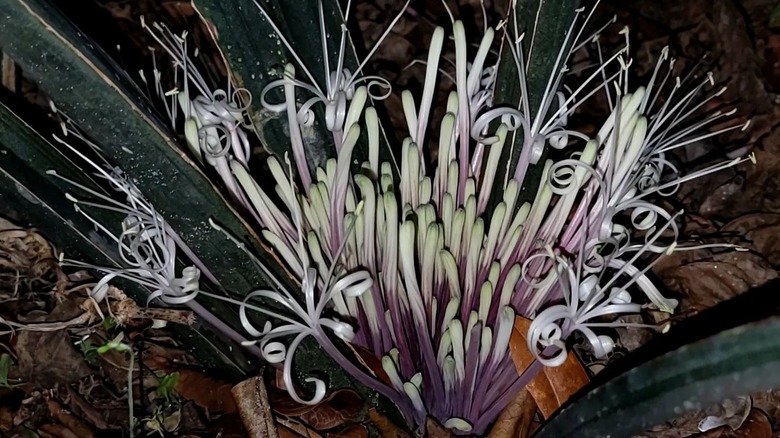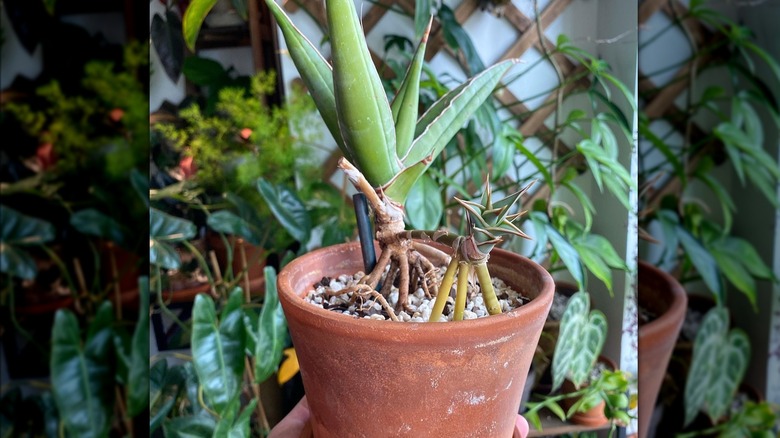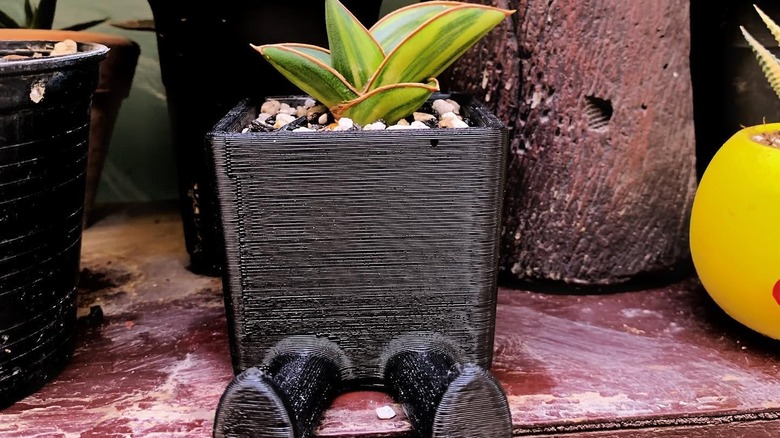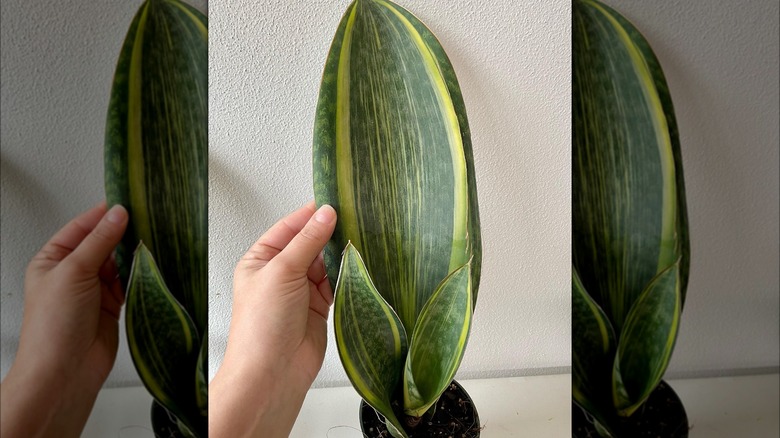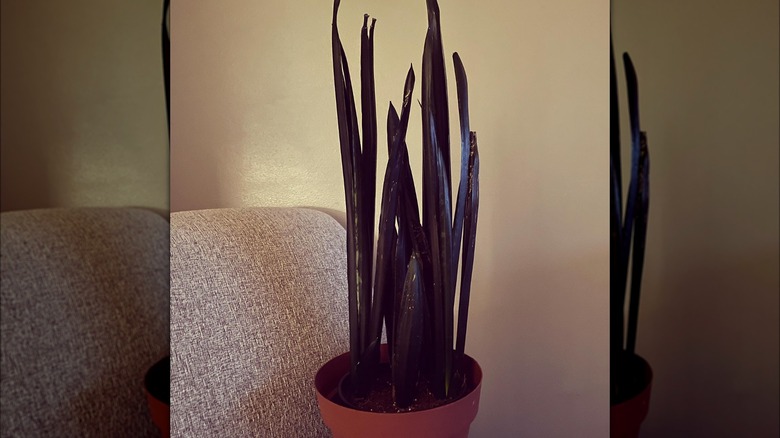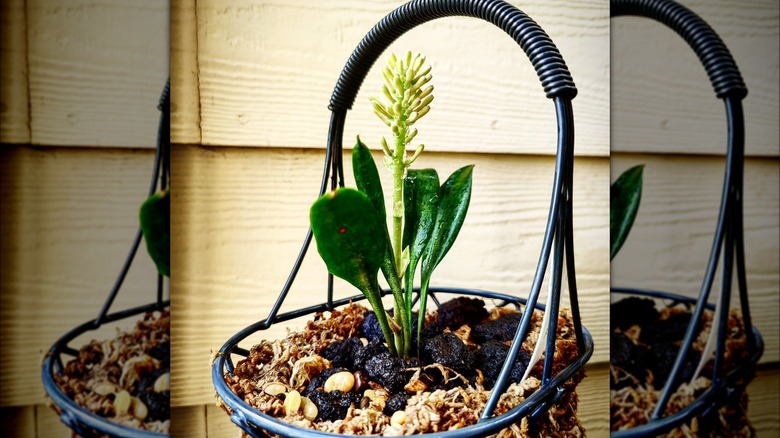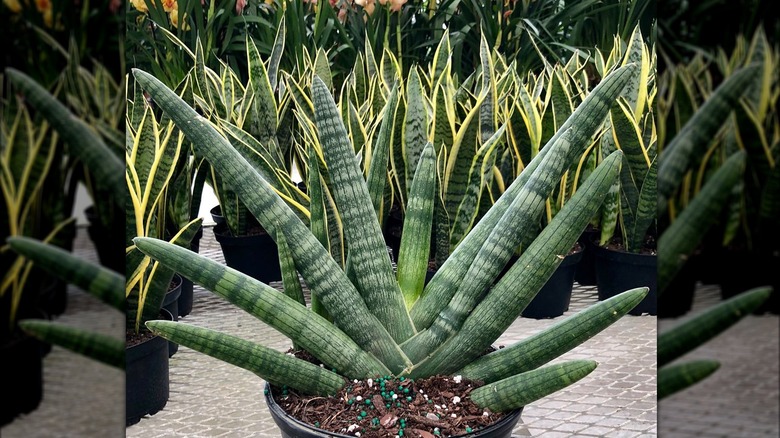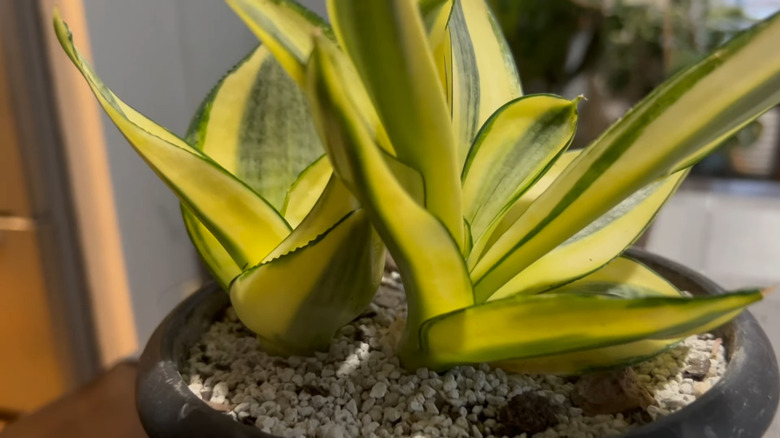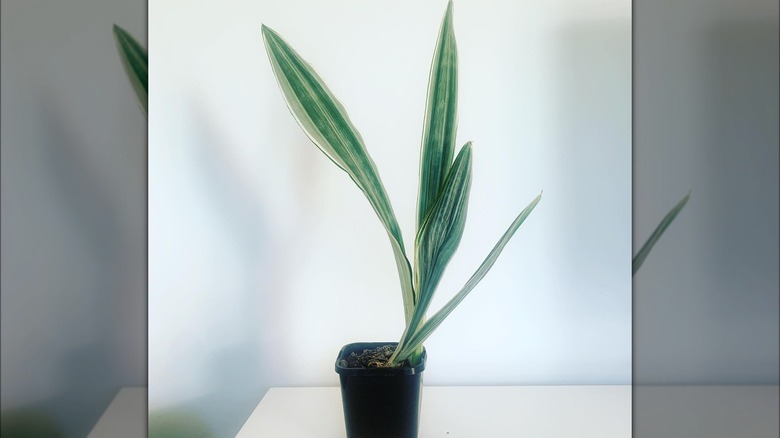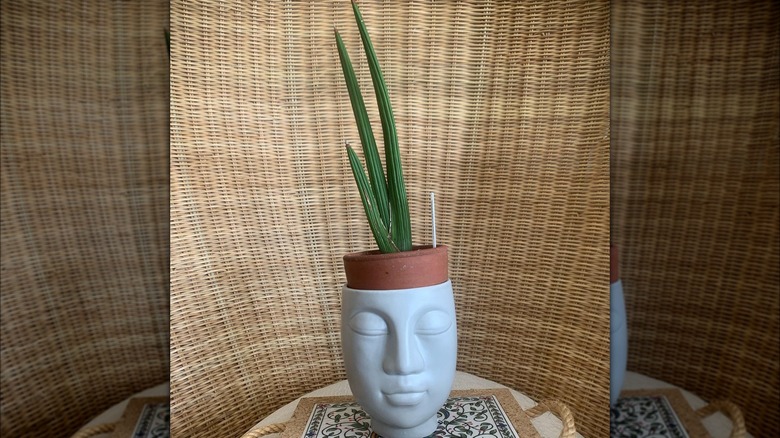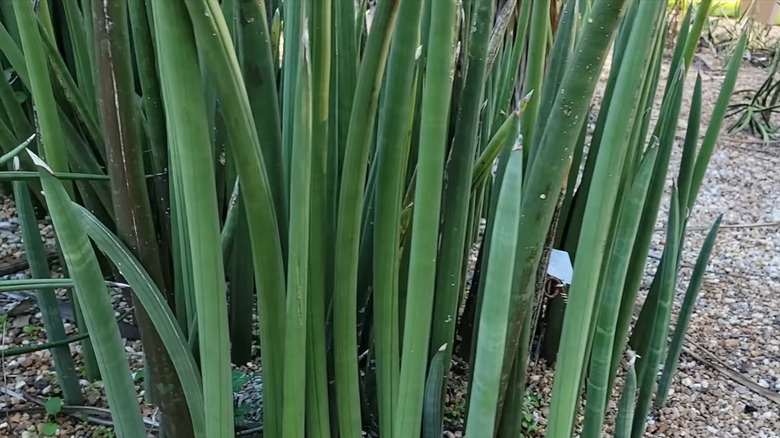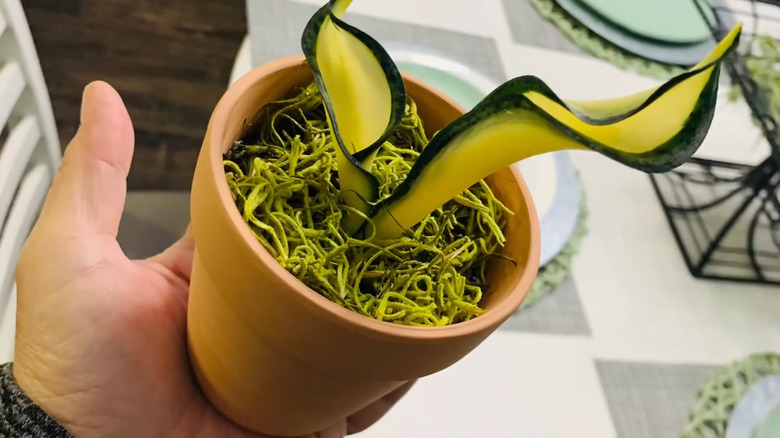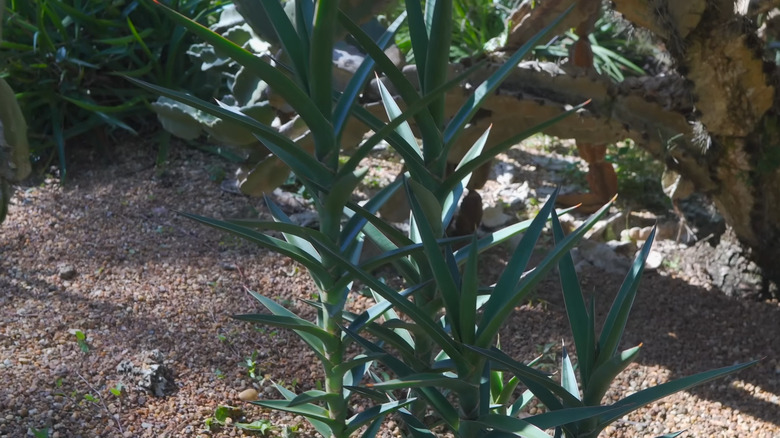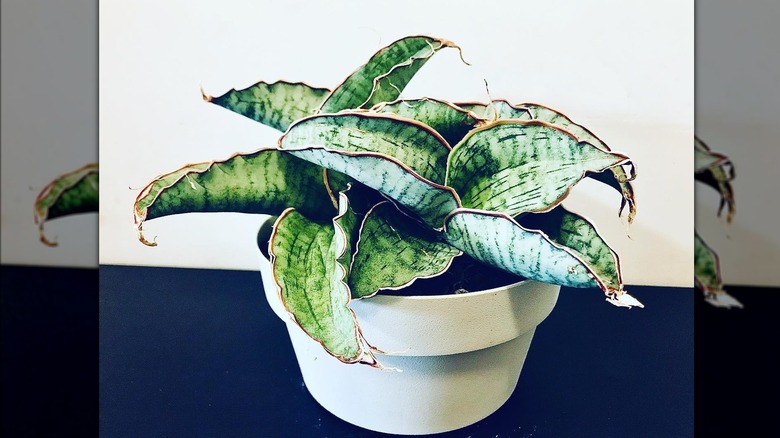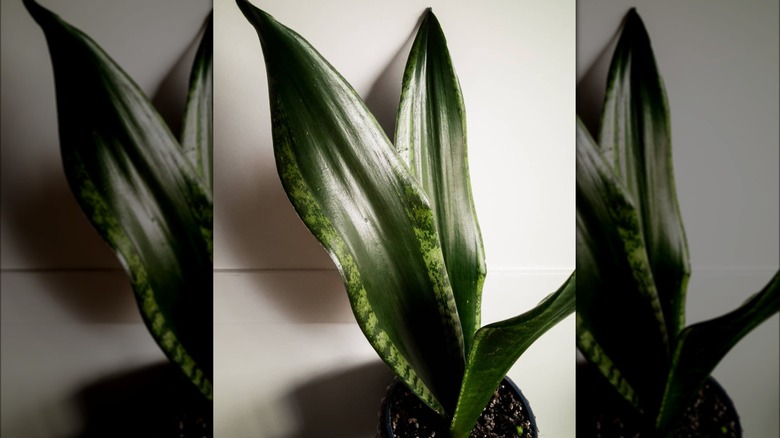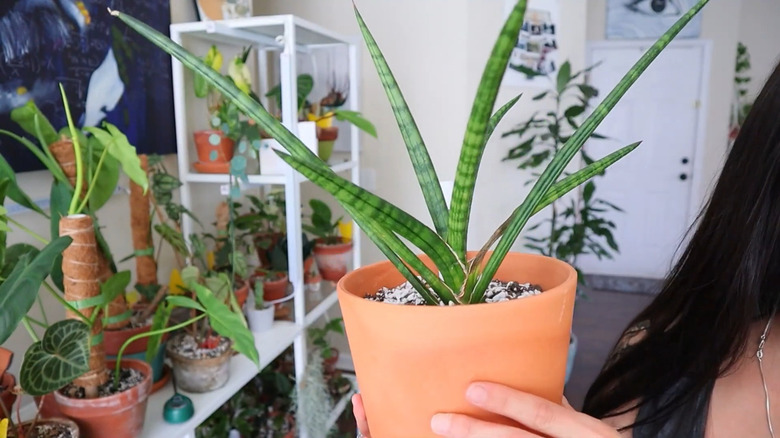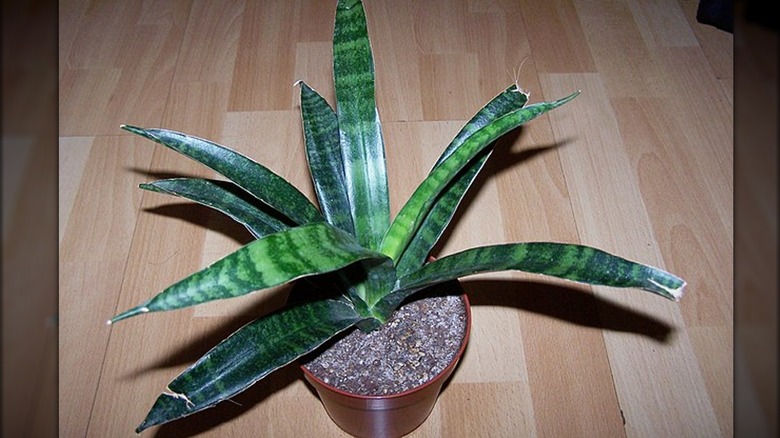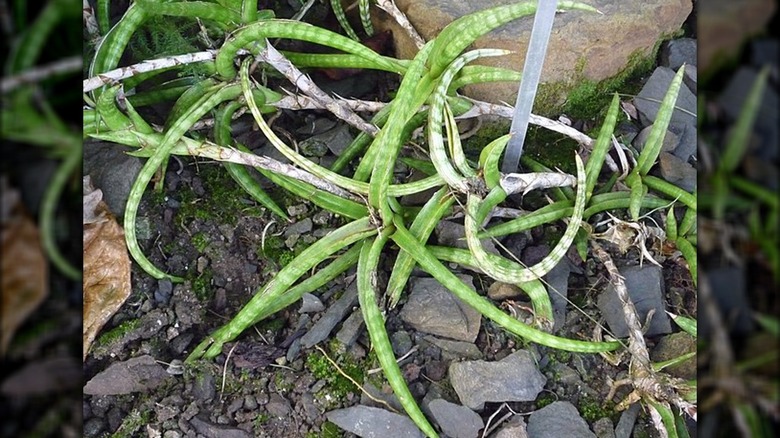28 Snake Plant Varieties That Are Perfect For Growing In Your Home And Garden
Unless you tend to grow your houseplants in soggy, wet soils or leave them in the sun's line of sight, learning everything you should know about snake plants (Dracaena, formerly Sansevieria) is a surefire way to earn the veritable bragging rights of being a green thumb. These African natives are unfazed by neglect, sitting cozily in their well-draining cactus potting mixes, putting up with your poor watering habits while rewarding you with purified air. They like shade, sparing you the hassle of finding a spot that fits the ambiguous definition of "bright indirect light." Most can be divided within three to five years, creating new plants (gifts for gardening friends!). Some even work as groundcovers in zones 10 to 12, provided it doesn't get colder than 50 degrees Fahrenheit.
With such attributes, it's no surprise that snake plants (which are also sassily called mother-in-law's tongue or a good luck plant if you follow feng shui) might be experiencing a resurgence in their popularity. But you'll have missed the mark if you're under the impression that the upright, slender-leaved, fleshy green foliage is all there is to this genus. With over 70 varieties and cultivars, snake plants showcase a magnificent display of genetic diversity in form, variegation, height, and more. Please note, though, that as a pet parent, you should be wary of growing this houseplant, as it can be toxic to them and make pets sick.
'Moonshine' snake plant
Minimalist decor lovers will rejoice in the pure elegance of a 'Moonshine' snake plant that could be the perfect addition to your home with its broad, silvery-green, pale leaves, earning the moniker "silver snake plant." It's tonally darker green with thin bands running along the foliage's edges. The foliage may grow a tad darker if placed in a dark corner. But to get your snake plant to show off impressive blooms, it needs morning sun. A slow-grower, 'Moonshine' matures to almost 2 feet tall and half as wide.
'Bantel's Sensation' snake plant
A sport of the much-lauded Laurentii variety, 'Bantel's Sensation' is for those who don't have a green thumb and want to avoid growing a plant indoors. Showcasing vertical snowy-white variegation, 'Bantel's Sensation' has gorgeous, olive-green foliage growing out of a rosette and tapering inward mid-point through. Measuring 1 ¼ inches across, this 3-foot, sword-shaped snake plant features among the more slender range of its species. It can grow outdoors in zones 10 to 12 if kept in a shaded location to shield it from winter rain. It could surprise you with aromatic, white blooms come spring.
'Fernwood Mikado' snake plant
If you want to commemorate your mohawk-headed, loud, punk-blaring days (or continue to do so), 'Fernwood Mikado' will suit your style. Unlike similar varieties, this snake plant has citron green tiger stripes adorning its much darker green leaves. The sleek, pointed foliage leans outward from a round base like a fountain, appearing indestructible while perched daintily on your desk. 'Fernwood Mikado' grows bushier as it matures to a 2- to 3-foot height and might require occasional misting indoors, so keep an eye out for any brown tips.
'Laurentii' snake plant
An inexpensive indoor classic, 'Laurentii' has carved a niche for itself through its emerald-gray, strap-shaped foliage with thick, creamy-yellow bands lining its rims. A closer look would show these innocuous-looking, fleshy leaves are quite sharp, with horizontal jade green streaks running across them. They must be grown in shallow containers, as they can tumble over if their 4 feet high and 2 feet across stature isn't supported fully. Being salt-, deer-, and rabbit-resistant gives them brownie points as foliage-forward plants in sunny to partly-shaded gardens of zones 10 to 12, especially along the coast.
'Jaboa' snake plant
Capable of scaling heights of almost 8 feet, 'Jaboa' is one of the tallest (if not the tallest) of snake plants. It has broad green foliage mottled with silvery-green smudge marks that sometimes curl up, resembling a fin. Other times, they flop over under their own weight! Although compatible with most homes' humidity levels, they have a thing for filtered light, so choose their spot accordingly. Even better, use them to give your decor an exotic spin by stationing them next to a bird of paradise plant.
'Twisted Sister' snake plant
Considered a dwarf cultivar of the Dracaena trifasciata 'Futura' variety, 'Twisted Sister' (sometimes called 'Gold Twist') is for those who love a cluttered look. The variegated, curved leaves assume the form of a 1- to 2-foot-high bird nest. The pale green leaves are stippled with green and white stripes, in addition to supporting broad, golden-yellow belts along the edges. However, since the foliage requires bright light to unveil its best colors, the best place to put this snake plant in your home is a sunny window, but draw the curtains when the sun is too intense.
'Coppertone' snake plant
Indigenous to Zanzibar, 'Coppertone' is a semi-succulent producing a 3-foot tall (rarely 4 feet) clump of undulating, pointed, leathery green leaves, which may exhibit pinkish tones when grown in full sun. In the summer, the red-edged, bronze-mottled, wavy foliage is embellished by a 2-foot-tall inflorescence encompassing clusters of stunning white blooms. However, once the blooms are done, so are the leaves. Since the variety has the distinct habit of producing underground rhizomes, it spreads laterally, spanning 5 feet wide. Cold-hardy to 30 degrees Fahrenheit, 'Coppertone' tolerates winter rains, making it perfect for xeriscapes.
'Black Coral' snake plant
Initially boasting foliage so black it would have the gothic heart pumping, 'Black Coral' matures into a 3-foot-tall clump of wavy, green blades. Not to be confused with 'Black Gold,' which has yellow brims, this snake plant is mainly riddled with horizontal avocado green-gray stripes, adding to its allure. Above all, 'Black Coral' can survive in the trickier, deeply shaded areas where most other plants give up, provided the soil drains well. Keen on sending runners, this 2 ½ wide plant can establish colonies 3 feet across in frost-free gardens of zones 10 to 12.
'Cleopatra' snake plant
'Cleopatra' is sure to stand out for its architectural, waxy, emerald-green foliage that forms a rosette instead of standing upright like most other cultivars. Curiously, it exhibits different color intonations, with its undersides appearing a creamy bluish-green. At the same time, the top seems much darker, attributable to the pronounced forest-green, longitudinal streaks and undulating, brownish-red margins. Since this Indonesian hybrid doesn't top over 1 foot inside homes, you can squeeze it in a small pot and keep it for tight nooks. It's the perfect snake plant for small spaces.
'Skyline Spear' snake plant
An Angolan import, 'Skyline,' or spear sansevieria, is perfect for adding a dramatic touch to your home. This snake plant produces near cylindrical, grayish-green fronds, subtly punctuated by fir green bands, which can be braided for an aesthetic touch. Growing 2 to 5 feet tall, the 1 ½ inch wide, rhizomatous succulent fans out in bright light, occasionally pleasing its growers with attractive, fragrant, pink-blushed, tubular white flowers that whirl about a raceme-like inflorescence. While it also tolerates low light conditions, its tapering leaves may turn limp, splaying wildly.
'Baseball Bat' snake plant
Named after its fleshy, sickle-shaped, grayish-green foliage that rounds at the top, giving the semblance of a baseball bat, this Sansevieria hallii variety is a collector's favorite. Due to its Zimbabwean roots, 'Baseball Bat' prefers slightly acidic, sandy soils. It doesn't thirst much after water, but the stripes crisscrossing its channeled leaves can dim down when kept overly dry. Spreading 4 to 5 feet wide, mature snake plants produce exquisite white-petaled and pink-tubed flower clusters from a short stem, adding a wash of color to shaded gardens.
Walking sansevieria
Lovingly called walking sansevieria for its juvenile roots that stand tall and pointy like stilts, Dracaena pinguicula is the plant that will keep chirpy colleagues from walking to your desk, thanks to its sharp, spiny foliage. When young, it grows a bluish-gray rosette of red-edged, waxy leaves that eventually separate into two rows, falling on either side of the stem. Cold-hardy to 15 degrees Fahrenheit, this succulent is drought-tolerant and prefers dappled or partial shade. With a compact, 1-foot stature, it can pass for an agave and is perfect for a xeriscape.
'Samurai Dwarf' snake plant
A diminutive form of sword sansevieria, 'Samurai Dwarf' isn't popular yet since it's rare to find and can be expensive. But if you find a spare leaf or can snag the plant off Etsy, it's sure to become the highlight of your plant collection. Growing super thick, V-shaped, pale bluish-green leaves that stack up one on one, inventively hiding the stem in plain sight, these unique plants give their cousins a run for their money with their much higher drought resistance. At 6 inches tall, they may sporadically form lavender-tinged, creamy white inflorescence in dappled shade.
'Whale fin' snake plant
Complement your aquarium with the one-of-a-kind Masoniana variety, 'Whale Fin.' This snake plant grows massive, almost 10-inch-wide paddle-shaped leaves, giving off an impression of a shark or whale fin if not for the soil. Pinkish-red lines run along its margins, punctuating the dark green-mottled, purple-sheathed, vivid green foliage. As it reaches a height of 4 feet indoors, some prefer growing it as a single-leafed specimen and propagating the rest. However, frequent division may stall their vertical growth at roughly 2 feet. Also known as 'Mason's Congo,' it grows in full sun to part shade.
'Zulu' snake plant
The almost black, dark green, dagger-like ferns of 'Zulu' make it the ultimate addition to the darkest crannies of your home. Not because the foliage merges with the darkness but because it can tolerate bad lighting. The downside is that it will grow slowly (as if snake plants aren't slow enough) and may die permanently if deprived of all light, so don't forget to soak it in filtered (not direct, or the leaves will scald) light intermittently. The over 4-foot tall and 1-foot-wide variegated variety has a few transversely placed yellow splotches, adding an earthy allure.
'Spoon' snake plant
To some, the Dracaena concinna (or 'Spoon' sansevieria) may seem unremarkable at first glance, given the non-existent variegation. But the staid green foliage does not define this variety's beauty. Instead, it's the shape. Although a shade lover, this snake plant assumes a rare, ovate form in bright, indirect light, reminding its spectators of spoons — a nice, tongue-in-cheek addition to the kitchen countertop, don't you think? It stays within 1 ½ feet, blooming white-flowered spikes from late spring to fall. Direct sun exposure will fold its leaves, so choose the spot carefully. It's only hardy outdoors in zone 12.
'Boncel' snake plant
Another standout cultivar from Angola, the 'Boncel' develops stubby, corpulent leaves that fan out like starfish as the plant matures to its 1-foot height. As you might've guessed, it's far more petite and fleshier vis-a-vis the upright varieties, lending it easy recognition. Ideal for small spaces, this snake plant thrives in rooms receiving ample sunlight without having to suffer its direct glare. You'll know when the light's low, as it will begin losing its sheen with the gray patches becoming more apparent. It's sometimes sold commercially as 'Spear orchid,' even though it isn't one.
'Golden Hahnii' snake plant
Another rosette, 'Golden Hahnii,' is the dwarf, variegated version of the famous 'Hahnii' or 'Bird's Nest' snake plant. Unlike its parent, 'Golden Hahnii' remains small, growing no taller than 7 inches. The stocky plant has vase-like, smooth gray-green fronds with bold yellow, vein-aligned borders that cluster together like a bird's nest, emanating solid "Look at me!" energy. It grows numerous offsets that can be separated for more plants, although the variegation pattern may vary. Place the pot in bright light to make its leathered foliage a focal point; otherwise, partial shade works.
'Metallica' snake plant
A spin on the Dracaena trifasciata 'Mabb' variety, 'Metallica' has joined the league of 'Laurentii' and 'Moonshine' with its spear-shaped silverish-green foliage. The silver intonations start stronger at the plant's base, eventually coalescing into longitudinal metallic lines running across the foliage's extent — they're also crossed by faint green horizontal belts. Brownish-red, wavy tips hyphenate the sharp, stiff, classically green leaves. It withstands most light and soil conditions but will grow slowly the longer it stays in the shade. Also traded as 'Siam Silver,' the 3-foot-tall perennial works as edging or in mixed borders.
Dracaena pearsonii (rhinograss)
Also known as rhinograss, Dracaena pearsonii is a cut above many thanks to its vertically ribbed, thick, channeled leaves shaped into a 2- to 3-foot wide clump. It differentiates itself from other cylindrical varieties through its dark green, deeply grooved foliage, which holds traces of brown and wounds up tightly. Winter-hardy to 25 degrees Fahrenheit, Pearsonii requires bright light to form white flowers that eventually make way for orangish-red fruit. The dagger-like leaves gain a length of 3 to 4 feet and may establish colonies through their underground rhizomes.
Dracaena singularis
Another variety that mimics an animal form, the Dracaena singularis (also called Sansevieria fischeri), sprouts chubby, prostrate, brownish-green leaves that curve inward, reminding one of an elephant's tusks. Thankfully, these forbs straighten their act as they age, rising gracefully as smoky gray-speckled, cupped, almost cylindrical green leaves with papery-thin, rust margins. In their native Kenya, they grow 8 feet tall and develop exotic lilac-white flowers closer to the base. However, as houseplants, they stay under 2 feet, blooming rarely, if ever. They may spring some sweet-smelling flowers in early summer if planted on sunny balconies or patios.
'Golden Wendy' mutation snake plant
This rare snake plant variety (mostly found on Etsy) will stun you with its gorgeousness. Unlike the typical green foliage, 'Golden Wendy' supports a jade yellow, somewhat chartreuse leafy base. The delicate leaves' borders are defined by irregularly shaped, mottled, forest-green bands that intensify the color contrast. To boot, the foliage twists and turns (like ribbons!) as it matures, taking the form of a rosette. Also traded as 'Henny Gold,' 'Golden Wendy' maintains a diminutive stature of 1 foot. However, the mutated variegation makes the plant super delicate.
Dracaena arborescens
It's undeniable that the Dracaena arborescens variety has a few things in common with its genus, like its tree-like growth habit, if we're being specific. These evergreen perennials are fast growers and thrive in full sun. Their succulent, 2-foot-long stems are swathed in waxy, flat, green leaves with pointed, red tips and are sturdier than the close-resembling Dracaena bagamoyensis variety. Indigenous to Tanzania and Kenya, they spread laterally through underground stolons to form colonies in the garden. It can be fully adapted for the outdoors in zones 9 to 13.
'Silver Blue' snake plant
Drawing on its eclectic, chunky, bluish-gray foliage, the 'Silver Blue' cultivar has built quite a cult following. Its leaves are ornamented by interweaving patterns of longitudinal and latitudinal, dark green bands, whose impact is exaggerated further by the wavy, doubled-lined white and red margins. A single leaf can grow up to 1 foot long and 4 inches wide, with the main rosette measuring upwards of 6 feet and 1 foot across. The perennial forb sends out runners in the garden to establish colonies. To encourage its greenish-white, conical blooms, plant in bright light.
'Whitney' snake plant
With an upright structure reminiscent of a dancing fire, the 'Whitney' or 'Silver Flame' snake plant is an apt addition to your home office. It boasts a striking variegation pattern, with the interior leafy area coated with a solid, forest-green color and the sides flashing a motley of emerald-green, sometimes silver, smudges. The succulent can grow to a height of 20 inches while spanning 6 inches across. Keep it in low light to enhance its dark coloration, or move it into bright light for a rare show of white flowers.
Dracaena suffruticosa
If you like long, spidery plants, you should get your hands on Dracaena suffruticosa. Like mangroves, their cylindrical, grooved foliage shoots out aerial roots perpendicular to the ground, adding visual appeal. Moreover, their ¾ inch-wide leaves quickly fill the space, turning the plant into a 2 ½ feet tall and wide, clumped shrub — thus the name. But you must protect your eyes from the sharp leaf sheaths, especially considering they spread laterally rather than relying on their central stem to grow taller. Plant in full sun to deepen the green bands running the length of their foliage.
'Kenya Hyacinth' snake plant
One of the hardiest cultivars that tolerates a temperature drop to 20 degrees Fahrenheit, 'Kenya Hyacinth' earned its name for the sweet aroma wafting from its pale pink blooms around evening. Growing no taller than 18 inches, it features finely textured, narrow, vivid green, variegated foliage that (thankfully!) tapers into soft, rounded tips. It works spectacularly as ground cover in areas receiving morning sun with little irrigation. Plus, winter rains can't hurt it. Alternatively, you can grow the snake plant in hanging baskets or containers to enjoy the view of suspended rosettes.
Dracaena ballyi
Found growing at elevated heights in shaded areas of Kenya, Dracaena ballyi is a dwarf cultivar that doesn't fold under our winter rains or poor lighting. Its short structure (4 inches at maturity) has utility for filling in the gaps and crevices along the driveway or a sidewalk. That being said, it works great as a houseplant when placed in a brightly-lit area. Spreading through gray stolons, it produces lance-like, fleshy leaves featuring comparatively lighter green bands, curving outwards. It may become showy in summer if its 1-inch-long greenish-white flowers make an appearance.
